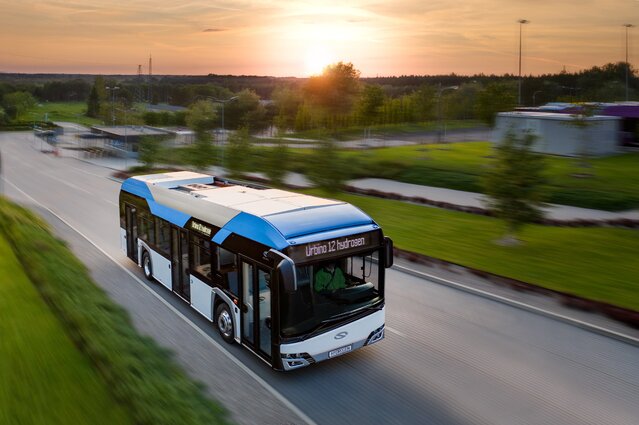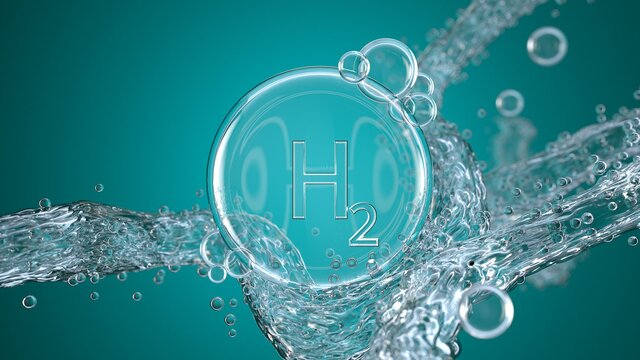The team you work in is investigating the possibility of developing a mobile hydrogen tank. What is the difficulty in producing such tanks for cars?
Hydrogen storage is a difficult subject in general and, in the case of vehicles, even particularly difficult. Hydrogen is the lightest element, and while a kilogram of hydrogen stores a record amount of energy, it also takes up a record amount of space. This is an important limitation for vehicles. We are used to the car’s tank being hidden somewhere between the rear seat and the boot, and we want it to stay that way. At the same time, we want to travel more than 500 km on a single fill-up.
How is hydrogen stored then?
Hydrogen storage methods can be divided into two main groups: chemical and physical. The greatest potential lies in the chemical ones, because water, for example, contains a great deal of hydrogen. The problem is that it takes more energy to extract it than we will get later from the hydrogen itself. However, there are other chemical compounds, including metal hydrides, which can be used as a handy hydrogen store. Unfortunately, none of them are efficient enough to be used practically. Therefore, while waiting for a good chemical warehouse, we focused on physical methods.
Currently, the most common way to store hydrogen is to compress it to high pressure. Two standards are now in common use - 350 and 700 bar (atmospheres). By comparison, we have a pressure of 2-5 bar in tyres and 10-15 bar in a pressurised coffee machine. Large steel cylinders, which supply, for example, welders on structures, withstand 150-200 bar. As you can see, with hydrogen we need to go further, which requires significant structural strengthening. In the case of tanks for vehicles, care must also be taken to ensure that they are lightweight so that the car is not overly heavy. At the High Pressure Institute we are developing technology that allows hydrogen to be stored at an even higher pressure of 1,500 bar.
What can withstand such pressure then?
Such tanks are made of carbon composite material. The inner layer of the tank is a so-called liner, made of plastic. It performs the same function as an inner tube in a bicycle wheel or ball - it doesn’t let gas through. Multiple layers of composite - carbon fibre bonded with resin - are wound onto the liner. This composite provides the strength necessary to hold the gas at very high pressures. It is also much lighter than steel. And we are proposing a new tank design to double the pressure of the stored hydrogen. Unfortunately, this will increase its weight, but also its safety, which is so important for everyday devices.

Are hydrogen-powered cars already on the streets today?
Yes, but you need a lot of luck to see one. There is not yet a single commercial hydrogen refuelling station operating in Poland. Polsat has the largest fleet of hydrogen cars, having bought around 40 last year and built a refuelling station for its own use. It is possible that it will later start building commercial stations. There are also single registered units, but they rather rarely take to the roads on their own power.
Will we one day be filling up with hydrogen instead of oil?
Of course, this is already happening in a few places in the world, including California and Japan. Let us also remember that hydrogen can power more than just our cars. It can be used for trucks, buses, trains, ships, construction and mining machinery. These are all separate applications, each with their own specificities. Hydrogen will develop faster in some areas and more slowly in others, and it will have to compete with other technologies. But success in one area, such as city buses, will automatically facilitate development in other areas.
How will this look in the case of passenger cars?
The problem is the size of the infrastructure needed. We are used to being several kilometres from home to the nearest petrol station, and on the road we get annoyed when we have to wait more than 15 minutes for the next one. In Poland we have almost 8,000 conventional filling stations, and the construction of hydrogen stations, which have a significantly different design, still requires a lot of time and enormous financial outlays.
Which is more promising: batteries or fuel cells?
An electric motor needs electricity, and this can come from chemical batteries, similar to those in our phones, or from a fuel cell connected to a hydrogen tank. Today, the use of battery-powered vehicles is much greater, most major car brands have such models in their range, and the fast-charging network in many countries already makes free travel possible. Remember also that such batteries can be charged, albeit slowly, from any electrical outlet.
However, this does not prejudge the battery’s victory in this race in the long term. For us all to move to battery cars, a significant expansion of the electricity grid would be needed to supply such large capacities to the charging stations. Hydrogen is more promising in this respect.

Source: Unsplash
How does a fuel cell work?
A fuel cell is a device that combines hydrogen atoms with oxygen atoms to produce electricity and water. Chemically, the process is similar to burning hydrogen in air, which can be used in a hydrogen internal combustion engine. The fuel cell allows this process to be carried out in a less explosive way, with the help of a membrane that allows protons to pass through. It is like a battery that does not need to be charged with electricity, but instead is powered by a fuel - hydrogen. The fuel cell has a much higher efficiency than the internal combustion hydrogen engine, i.e. from one kilogram of hydrogen we obtain much more energy to power the car.
And where is hydrogen already being used on a larger scale in automobiles today?
In specialist applications, hydrogen may already rival batteries. For a city investing in ‘clean’ buses, it makes no difference whether it spends money on electric or hydrogen charging stations. The only issues that matter are availability, price and running costs. In this respect, batteries have an advantage of some 5-10 years, but the gap is narrowing and we can expect to see hydrogen-powered buses in Polish cities.
What is the safety issue for such engines? Are these solutions safe?
All hydrogen vehicles are built from start to finish with this gas in mind and undergo comprehensive safety tests. Hydrogen can be just as dangerous as electricity in a socket, gas in a cooker or cylinder, petrol in a car tank or electrolyte in a battery. And as with any of these substances, you have to know how to handle it. And we already know how to do it, so we can use hydrogen 100% safely today. It even has certain advantages over natural gas, for example. Due to its low mass, it rises very quickly into the atmosphere and does not cause prolonged fires.
How is green hydrogen obtained?
Green hydrogen is hydrogen derived from renewable energy sources - solar, wind and biomass. It leaves no carbon footprint. The grey and blue is that which comes from fossil fuels. This is an important distinction, because hydrogen has been used for a long time and in large quantities in industry, but was mainly extracted from natural gas. From an environmental point of view, the use of grey hydrogen is therefore not significantly different from running a car on LPG.
What else will hydrogen be used for?
Hydrogen is of great importance not only because it is ‘green’ in itself, but also because it makes it possible to store renewable energy. At present, the overproduction of such energy is fed into the conventional power grid, which is also where we draw energy from if there is a temporary shortage of renewable sources such as wind or solar power. This system works as long as renewables are small compared to carbon. However, if we want to switch completely to RES, we need to generate energy storage. This is where chemical batteries and green hydrogen come into play.
Thank you for the conversation

Source: Solaris press materials







